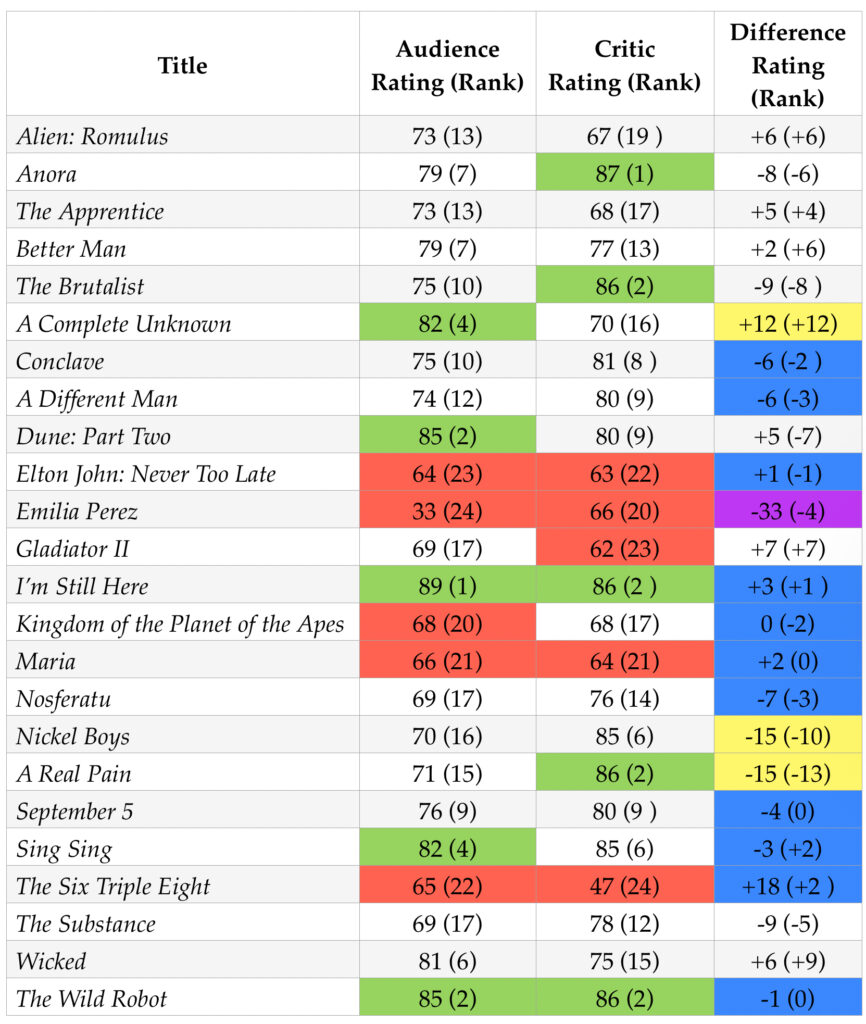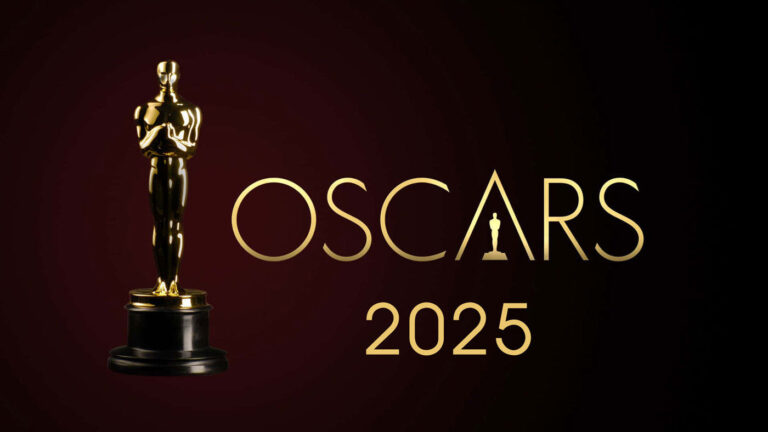Discussing the 2025 Oscar Special Interest movies is relatively easy because there are three distinct categories and each of them have just five movies. All the remaining movies fill in the rest of the nominations scattered among 17 categories. (For more details on how all these terms are defined, I refer you to a previous post, 2025 Oscar Movies: Initial Analysis.). There are 24 movies in this category and so discussing them can get complicated. I will start with the raw data (ratings and rankings) and then point out the highlights. Note that I haven’t seen any of these movies yet…my analysis is based only on the data.)
(There is a data table presented below. For an explanation of what the numbers and colors mean, please go to the bottom of this essay.)

There is a lot of information in that table but I have tried to identify the highlights in the discussion below.
Two films, I’m Still Here and The Wild Robot, both came out at the top of both group’s lists. The films are so different in subject matter and style that it speaks to the power of cinema to span such diverse areas and to generate favorable opinions from two very different sets of people, typically with different likes and dislikes. I’m Still Here recounts the effects of a dictatorship on a Brazilian family in 1971, while The Wild Robot is an animated story of artificial intelligence shipwrecked on an island where it learns from the native animals. It is a testament to cinema that two radically different stories could generate strong enthusiasm in two often different viewing groups.
The two groups did not agree, though, on which of the movies should fill out their top-five. Audiences went for the science fiction spectacle, Dune: Part Two, Sing Sing, a drama about the power of art in a prison environment, and the Bob Dylan biopic, A Complete Unknown. For unknown reasons, audiences and critics radically disagreed on the Dylan picture, expressing the largest audience over critic difference of all 24 general interest movies.
Critics filled in their top five slots with three very different movies, although they all involve people with European roots. Anora relates the tale of a prostitute living a fairy tale life with a rich Russian in Brooklyn. The Brutalist is a very long movie about the transplant of that particular architectural style from Germany to the United States and the people who did that. And, finally, A Real Pain follows two cousins touring Poland to reconnect with their family history, surfacing some strong feelings from both. This last film is one of two showing huge differences of opinions with critics enjoying it, and general audiences not – the opposite reaction from the Bob Dylan picture.
There is one more film that critics really liked more than the public, although it did not appear in either groups top or bottom five. That would be Nickel Boys about two Black boys in reform school in Florida. It ranked sixth among critics, but just 16th in the opinion of the general public.
Just as interesting as the top rated films, are those in the bottom five of each list. Interestingly, both groups identified four of the same films as bottom-dwellers. There is, of course, Emilia Perez which is at the very bottom of the viewing public’s list and near the bottom of the critic rankings. That this movie also became the darling of this year’s Oscars (with the most nominations and the highest score on my OQI), just simply defies explanation. The transgender subject matter may very well generate audience backlash, especially in this new Trump era. But it is unclear why critics also place it near bottom when the Academy, which rarely varies a lot from critical assessments, gave it their top accolades! So Emilia Perez is the confounding element in any assessment of this year’s Oscar movies.
The other three films that both groups disliked are not as controversial. The Six Triple Eight tells a World War II story of how nearly a thousand women fixed a mail delivery problem affecting 17 million items. Maria has Angelina Jolie telling the story of, and sometimes actually singing like, Maria Callas, often considered the world’s greatest opera singer. Finally, Elton John: Never Too Late, simply didn’t cut it with either group. So, opera and mail – perhaps the subject matter just didn’t strike an exciting nerve, and I can relate to that. But Elton John? I mean who doesn’t like Elton John. So maybe it just isn’t a great movie!
The two groups differed on which film rounded out their bottom-five lists, but the disagreement wasn’t real strong, only a rank or two. Audiences liked Gladiator II somewhat better than critics who put it in their bottom list. While the opposite trend happened with Kingdom of the Planet of the Apes. I must say I’m somewhat surprised that the viewing public put the latest Planet of the Apes movie in their bottom list – perhaps the energy has run out of that franchise. And I don’t know exactly what is generating the negative feelings about the Gladiator sequel, although we should note that it’s been 24 years since the first one which is at least a generational difference.
It is often very enlightening to talk about the movies where critics and audiences disagree about the film, especially when the disagreement is really strong. Those films are highlighted in yellow in the table and I’ve discussed them above. But I thought I’d end this analysis with a brief list of where the critics and the public ranked the films within one or two spots on the ladder. While their scores might be off a little more, their comparison with the other films on the list is generally about the same. Those films are highlighted in blue in the last column in the above table. It is refreshing that the two groups are in general agreement about nearly half of the movies!
All the other films, that don’t have any highlighting in the table – or that I haven’t specifically mentioned – are all films that don’t appear in either group’s bottom or top lists, and although they show modest differences in ratings and rankings between the two groups, they do not show dramatic differences. Next essay will combine this information to present a relative ranking of all 35 movies. And that’s without having seen any of them.
Reading the Data Tables:
Column 1: The title of the movie in this comparison.
Column 2: The general/public audience reaction to this film. The first number is the rating I have calculated, based on two public rating scales and for which I have modified them to make them comparable. A green background indicates the film is ranked highest. A red background means it comes in last. When there are more than one movie of the same color, that is because they achieved the same numerical rating.
Column 3: Same as Column 2 except for the critical assessments as aggregated by two different sources.
Column 4: The difference between the Audience and Critic ratings and ranks. The first number is the difference in rating. A negative number means the critics rated the film that much higher than the public. A positive number shows those films the public liked better than the critics. The number in parentheses is the numerical difference in rank number. A blue background is where there was no relative difference between the two groups – the ratings might be different, but their ranking in this set of films isn’t meaningful. A yellow background shows a difference of opinion on the relative value of that film compared to the others in this group. (A purple background is reserved for Emilia Perez which is clouded in confusing numbers.)
Measurement Notes:
I have identified some anomalies in the data on the following films, which suggest that some of the conclusions presented above might be suspect. This most often (but not in the case of Emilia Perez) occurs because of a very small sample:
Emilia Perez: Major differences in both the internal audience and critic scales – the reactive data to this film is a mess and is difficult to interpret.
Nickel Boys: Strong difference in the two critic scales.
Nosferatu: Strong difference in the two audience scales.
The Brutalist: Strong difference in the two audience scales.
Sing Sing: Strong difference in the two audience scales.
A Different Man: Strong difference in the two audience scales.

